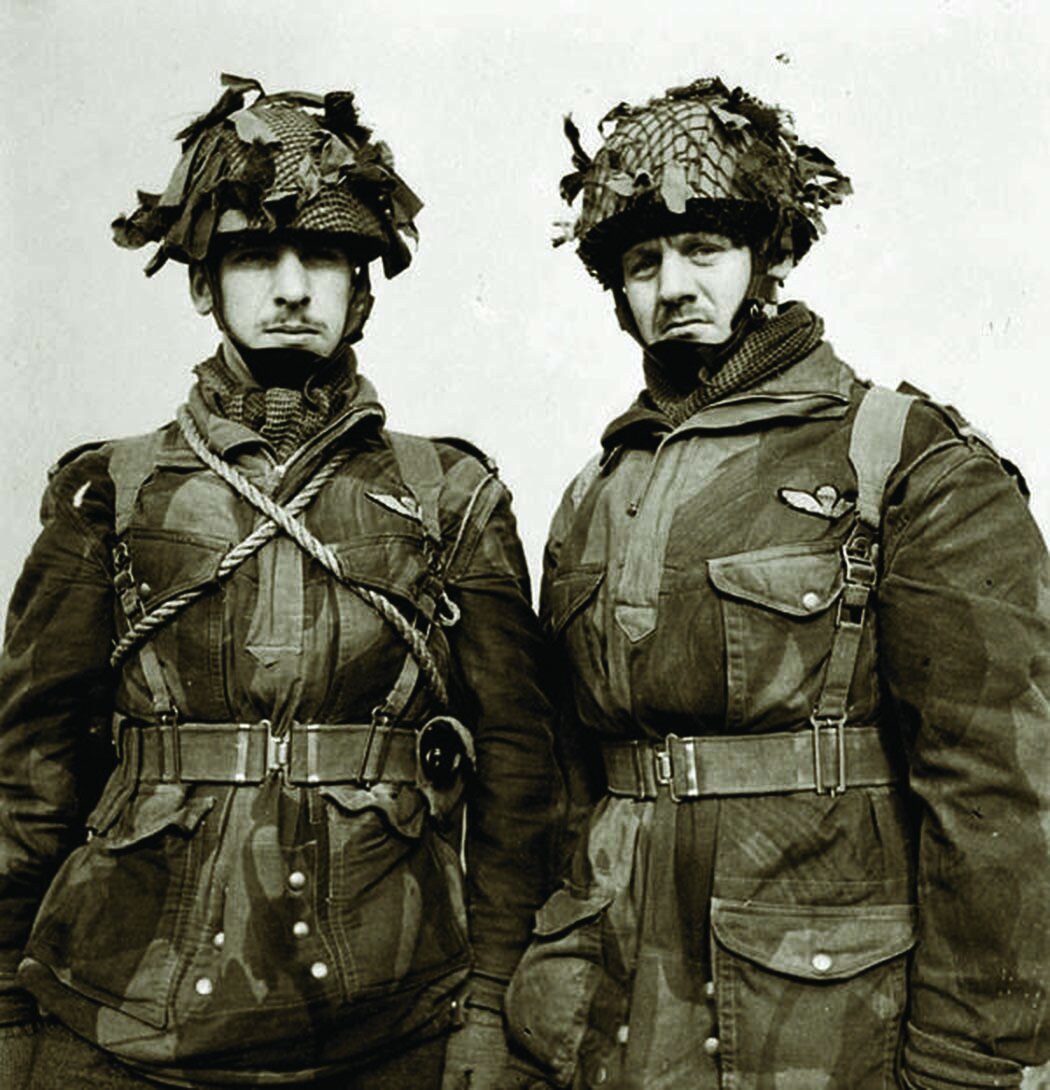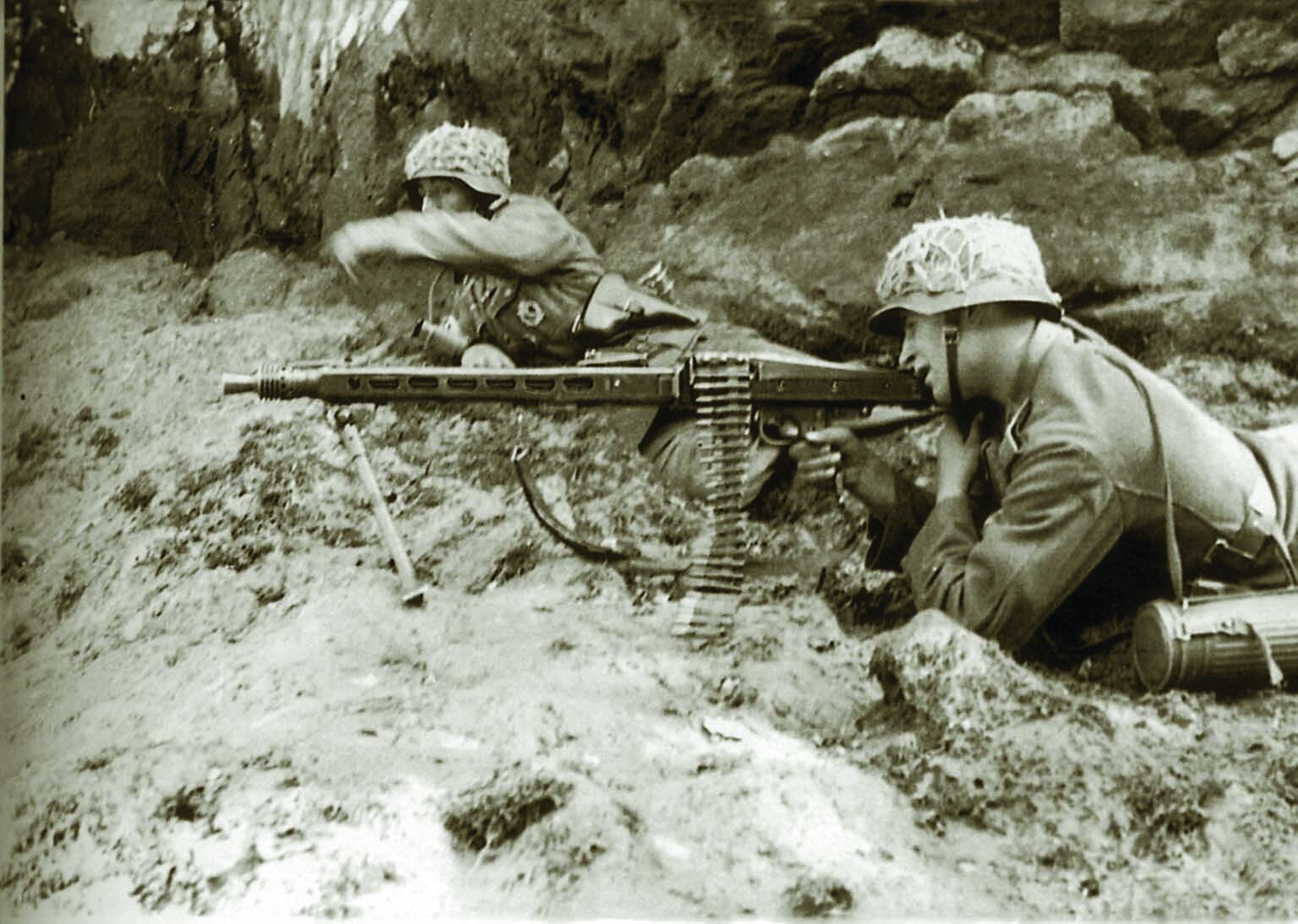Members of the 1st Canadian Parachute Battalion regroup and rest following their airborne assault on Normandy in advance of the D-Day landings.
By Mark Zuehlke
Stunned by the ferocity of this charge, the grenadiers took to their heels and several were taken prisoner. One of the captured soldiers warned that the “Germans were desperate to capture the brickyard and the crossroads.” Having had the wind knocked out of them, however, the grenadiers opted against launching a second attack in favour of sniping at the Canadian lines and harassing them with mortar and artillery fire.
The sudden appearance of the 346th Division on his front left Bradbrooke with two quandaries. First, there was obviously now a large, determined German force between the crossroads and Robehomme, where Captain Griffin and the hundred paratroops with him were besieged. The lieutenant colonel was anxious to find a way to extract those men before they were overrun. Second, the Germans were obviously well endowed with armoured support—something he totally lacked. Leaving the German commander free to attack the Canadian front at will guaranteed that the combined tank and infantry forces would eventually penetrate the line and possibly overwhelm his men.
Bradbrooke decided the solution to both his problems was to be found in aggressive patrolling. While sending fighting patrols towards Bavent to throw the Germans off balance and perhaps force them to assume a defensive posture, he would also send a small patrol through the Bois de Bavent to find an unblocked route to Robehomme that could be used to guide that unit home. Lieutenant Bob Mitchell, who commanded ‘A’ Company’s No. 2 Platoon, drew the job of trying to get through to Robehomme. Knowing he could only succeed by remaining undetected, the lieu- tenant decided to take just three men along. Private Ray Newman, who had proven his worth the night before as a scout for Mitchell, walked point. The other two men were selected more for their language skills than fieldcraft. Private E. Schroeder spoke fluent
German, while Private L.S. Jones was equally adept at French. In the early afternoon, Mitchell and his three men crept past the front lines towards the woods. Newman thought it a shame to be going on such a mission with an empty stomach, but there had been no alternative. No rations had come up with the ammunition and heavy weapons, so food was in desperately short supply. Of course, when the paratroops were in action they would always take bullets over food. Death by starvation was not as likely as being killed by the enemy.
It was still light when Newman spotted “a character skulking along the edge of the Bois de Bavent. He was wearing a black beret, a civilian coat and airforce blue pants. He didn’t fool us for a minute. We lined him up in our sights and ordered him to advance. Sure enough, he turned out to be a Canadian Typhoon pilot who had been shot down on D-Day and who was now very relieved. We explained to him how to behave in the kind of territory we were in, and sent him on his way to le Mesnil.”
The patrol pushed into the woods on a three-mile circuitous trek Mitchell had mapped out as the most likely route for reaching Robehomme undetected. Out on point, Newman kept expecting to sight enemy soldiers at any moment, or at least French civilians. But the forest remained eerily devoid of life. They had been briefed that Robehomme was surrounded, yet the four men passed through the woods without incident. Even more to Newman’s surprise, they were then able to move up a soggy lane running through flooded pastures and fields to where it intersected the road running from Bricqueville to Bavent. It was now dark, and the Germans covering the road from a position east of Bavent failed to notice the patrol as it struck off on the raised roadbed running through the flooded ground that ended just short of Bricqueville. Skirting this settlement, which seemed deserted, Newman led the patrol into Robehomme by moving off to one side of a small road. That they made it through struck Newman as being nothing short of “miraculous.”
Of the forty or so Canadians at Robehomme, thirty-five hailed from ‘B’ Company, while only a handful of the British paratroops were from the same unit. This meant the Canadians had the most cohesion as a fighting force, so Griffin decided they would lead the way out, with Mitchell’s little patrol on point as guides. Those wounded soldiers unable to walk were either put into a car volunteered by Robehomme’s priest or a horse-drawn wagon provided by a local farmer. At 2330 hours, the entire force filed quietly out of Robehomme and headed into the darkness. Several times, the car, wagon, or both bogged down in mud, requiring a lot of pushing and pulling by the men on foot to wrest the stuck conveyance free.
Two officers of the 1st Canadian Parachute Battalion in England on the eve of the D-Day invasion.
German infantry conduct an exercise in Normandy ahead of the expected allied invasion.
Just past Bricqueville, a German sentry barked a challenge. The men at the head of the column immediately rushed the position, firing as they did so. In a matter of seconds, they killed seven of the eight Germans maintaining a guard post and captured the other. A few minutes later, “an automobile with headlights dimmed down to...narrow slits, and which therefore appeared ghostly, was perceived sliding along the Bavent road towards the column. When it was quite close it met a fierce volley of well aimed fire from our column,” the battalion’s war diarist later wrote. “It careened into a ditch and upon examination was found to contain the dead bodies of four German officers. The way was now clear to get on through the Bavent forest.” At 0330 hours, the column reached le Mesnil crossroads. The Canadians were quickly integrated back into their units, which greatly bolstered the fighting strength of ‘B’ Company, and the British troops headed off to return to their various units.
While Mitchell’s patrol was engaged in rescuing Griffin’s force, Bradbrooke had also sent out three ‘C’ Company patrols over the course of the day towards Bavent. Although the first patrol was to use stealth to reach the village, avoiding enemy contact was not in the plan. Rather, Sergeant Harvey Morgan was going to attack Bavent with six men, while Corporal Dan Hartigan and Private Colin “Wild Bill” Morrison of Innisfail, Alberta covered them from a low rise to the right of the village. For this job, Hartigan was packing his two-inch mortar, a rifle, two bandoliers of rifle ammunition, all the mortar rounds he could scrounge, several grenades, and a Gammon bomb. The latter weapon, formally known as a Type 82 grenade, was a canvas bag stuffed with two pounds of plastic explosives fitted with a tumbler fuse covered by a plastic cap. Removing the cap exposed a detonator atop the fuse, which, when subjected to the slightest motion or impact, exploded the charge. The weapon had been invented by British paratrooper Lieutenant Jock Gammon to give airborne troops an ability to fight tanks without having to carry heavy conventional antitank mines. Morrison, “a huge raw-boned farm lad of twenty-one,” was equally heavily loaded down with bandoliers of magazines for his Bren gun.
These lucky Canadian paratroopers have managed to obtain a jeep.
Members of the 1st Canadian Parachute Battalion pose for a group ‘hero’ shot in England on the eve of the D Day landings.
The purpose of this nine-man attack on Bavent was “to make the enemy fire as many of their weapons as possible, and so give the Canadians an estimate of their strength in the village.” During the pre-patrol briefing, Morgan had calmly told the men that while Hartigan and Morrison covered them, he and privates Gilbert Comeau, Bill Chaddock, Clifford Douglas, M.M. “Pop” Clark, Eddie Mallon, and Jack Church would charge up the main street until Morgan yelled, “Take up positions!” Then all but Morgan and Chaddock would take cover and start sniping at anything that moved. Morgan and Chaddock, meanwhile, would attack the near- est two-storey building—nobody cared which one—and sweep it clear in a standard enter and search manoeuvre in order to wipe out any snipers or machine-guns positioned in the upper storey or on the roof. It was expected that the audacity of this action would badly shake the Germans in the village and weaken their resolve to tackle the obviously fighting mad Canadian paratroops.






